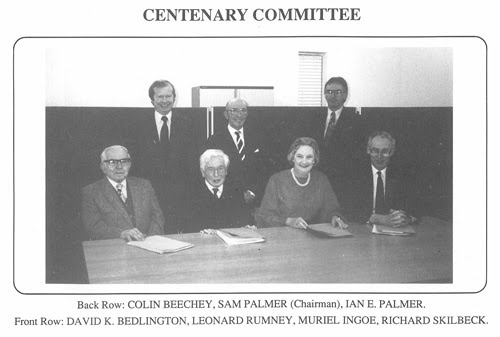Our History
EARLY BEGINNINGS
The first reference leading to the Official Opening of the Mission in Wellington Street is contained in the Minute Book of 1892 which refers to a meeting held on 6th March that year and reads as follows:’ ‘resolved that the new Mission Room be opened on Easter Sunday”. Mr. Richard Adcock was the Chairman at that important Meeting. This means that the birthday of the Mission is 17th April, 1892 and Good Friday in 1992 is on the same date. Of course it will be realised that much work must have been done leading up to that eventful decision.
What we do know is, that as far back as 1877 Mr. George Bowman a Londoner who had arrived in South Shields at the age of sixteen, to work in the area and now twenty-four years of age, joined with three other working men, Richard Adcock.
William Pinkney and Thomas Elliott, to establish the Mission in a room in Albion Street, for which they each paid sixpence per week. Previously, for an indeterminate time they had been Members of the Town Mission, which had become defunct.
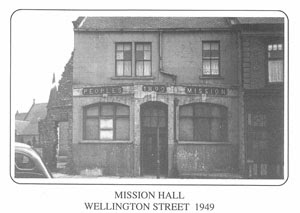
The question has sometimes been asked, “why the title People’s Mission?”- it may be that the clue lies in the placing of the apostrophe between the letters ‘e’ and ‘s’, indicating the possessor – in other words the intention was that this new Mission should belong to the people.
Now that the new Mission Hall was opened the next task was the appointment of Trustees – even today becoming a Trustee is not to be taken lightly, and just over a year later on 12th April, 1893, ten were so appointed. These were Messrs. Adcock, Alderson, Bowman, Brogden, Coskie, Dunn, Elliott, Jefferson, Moore and Tennant. The observant reader will perhaps wonder what happened to Mr. William Pinkney mentioned earlier, who with the two others commenced the fellowship in Albion Street in 1877. Unfortunately we do not know, but it would not be unreasonable to suppose he died between 1877-1892.
Mr. George Bowman previously mentioned as one of the Founders and a Trustee was appointed to the position of Mission Secretary on 21st March, 1894, and also Superintendent of the Sunday School, both appointments he held until he was called to Higher Service in 1932. His work for, and the love of children, gained him a special place in their hearts, so that when they were asked what Sunday School they attended, the answer would nearly always be “Bowman’s Mission”. It is not without some significance to note that one hundred years on his two great, great grandchildren Janet and Angus Griffin attend the Mission today as Members of the Girl’s and Boy’s Brigades.
Of course, it is to be noted that in those early days whole families became interested in what was happening in this modest building and not only joined the Mission, but became valiant workers. Their names are penned in the records leaving no doubt that their personal commitment and testimony to a saving faith in the Lord Jesus Christ, was instrumental in building up a Fellowship which a few years earlier could not have been envisaged.
The temptation to mention names is irresistible but, at the risk of possible omissions we record a few whose service and those of their families, can never be forgotten, nor should they be.
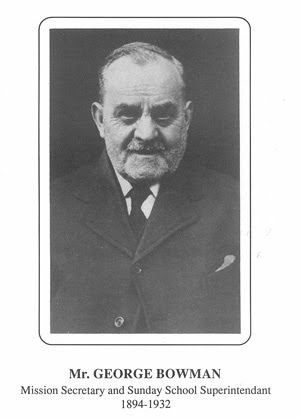
James Brimer, Cuthbert Peel, Edward Coulson, Charles Bedlington, David Ogle, William Alderson, F. Moore, W. Lascelles, T. Noble, D. Addison, M. Seales, J. Gibson, Lawrence Garrick, Robert Urwin, Henry Hogg, Alex Todd, J. Beck, J. Abernethy, John Jarret, Elijah Cook, William Shadforth, George Charles and many others.
DEVELOPMENT
At the Annual Meeting of Members held on 12th April, 1893, a number of important decisions were taken, apparently all in one afternoon! It would appear that Members were divided up into classes, each with a Class Leader and headed by Mr. Richard Adcock. This, of course, the Methodist Church has been doing since it’s inception, a tradition that is still in operation today in that denomination. The Meeting then went on to establish a Young Mens’ Class, under the leadership of Mr. Robert Urwin, a Christian Endeavour Society was also formed as was a Mission Band.
The Mission Band referred to above was not a band as we know it today – it was simply a crowd of Members who, in procession, marched the cobbled streets in the Mile End Road area, persuading all who would listen, their need of a Saviour. To this end regular Open-Air Meetings were held on Tuesday evenings, with a prayer Meeting at seven o’clock, on Sunday mornings followed by an Open-Air Meeting at around ten o’clock. It was, however, to be some years hence before the Band became a marching band equipped with brass band instruments.
From the records it would appear that between 1893 and into 1896 there was a substantial increase in membership, the Sunday School was increasing in numbers to such an extent that accommodating the children was becoming a problem. However, after more than four years occupancy, it was decided at a Workers Meeting on 14th October, 1896, that the Mission Hall was ready for a spring clean and in order to make this possible, all Members were asked to subscribe to a Special Fund. The total collected was £2. 13s. 6d. with expenditure for materials at £2. 12s. 5d. leaving a balance in hand of one shilling and one penny.
In the same year on 20th December, 1896, it was proposed and agreed that Meetings should be held on Christmas Day with the following arrangements:-
Missioning the streets on Christmas morning after a Prayer Meeting at 9.30 a.m. In the afternoon at 2.30 p.m. a Meeting for fellowship followed by an Open-Air Meeting 5.30 p.m. at the corner of Bath Street and finally, a Meeting at night at 7.00 p.m. at which a special collection would be taken for the Children’s Treat to be held on Boxing Day.
Development continued in 1897 when a Pentecostal League of Prayer Meeting was commenced on a weekly basis. Undoubtedly the highlight of that innovation was a visit to the Mission of it’s founder Reader Harris Q.C. An unusual feature of this auxiliary of the Mission was the fact that the ladies wore special bonnets similar to, but slightly different, from those worn by female Members of the Salvation Army. The men, in contrast wore a single ribbon on their lapel, indicating that they too were Members.
On 5th January, 1898, it was decided to paint the interior of the Mission Hall and at a Meeting held on that date the Minute reads, “that the paint be seen to at once and the Secretary (Mr. George Bowman), and Thomas Elliott, canvas the town for subscriptions on behalf of the Mission”. When the walls had been painted, consideration was given to including scripture verses behind the pulpit. A number of texts were examined and the following were chosen:
“Prepare to meet Thy God”, “Holiness unto the Lord” and “Christ died for our sins”.
There were two further innovations in 1898. One at a Meeting on 16th November, when for the first time, it was agreed to hold a Watch Night Service on 31st December and secondly, on 21st December it was unanimously agreed that “we as a Mission support Bro. Ajcock’s recommendation to get brass instruments for the work of the Mission”. This then was the birth of the People’s Mission Silver Band when on 18th January, 1899, the first rules of the Band were approved by the Workers Meeting. A further rule was added on 15th March, 1899, to the effect “That no-one become a Member of the Band until the expiration of three months after confessing conversion”.

On the 11th April, 1900 a Christian Endeavour Society was formed to meet on Thursday evenings under the leadership of Bro. Noble.
It became evident now that the Mission was growing rapidly, clearly the intense Open-Air work was reaching out to hundreds of people who were responding to the regular appeals made to them. This, of course, has to be set against the socio-economic climate of that period, when living conditions by todays standards were appalling, with large families living in tenement houses, with no running water indoors and obtainable only from a communal tap in the backyard, servicing as many as thirty people.
The Sunday School benefited from the fact that in those days seven to ten children in one family was not unusual, although the mortality rate was high.
With growth of course came problems, some worrying others humorous. A typical example was the case of two Members who fell out with each other, one of whom put the matter in the hands of a solicitor and, at a Special Meeting it took the Members who attended, a great deal of pleading with that gentleman to withdraw the charges.
The Silver Band were invited to play at the Sunday Evening Service on some occasions, but one Member in a Business Meeting, and I quote, “asked the Band not to play inside the Mission on Sunday nights as it was injurious to his wife”.
On 3rd October, 1900, a further extension of the activities was considered and approved to the effect that with effect from the first Sunday in November and monthly thereafter, the Sacrament of the Lord’s Supper would be observed.
The records appear to suggest that the next few years were devoted to consolidation rather than expansion, which is not surprising, given all that had been achieved in a few years. Business Meetings previously held monthly were now held quarterly, but there was no diminution in activities. As examples, Cottage Meetings were established, infant baptism was introduced but only for the children of Members, a fund was opened’ ‘for the sick, poor or distressed”, almost at every Meeting there was an influx of new Members as many as thirty in one quarter. A Choir was formed who previously had to rely upon a small harmonium for accompaniment, but it was decided to buy a new organ of a superior quality.
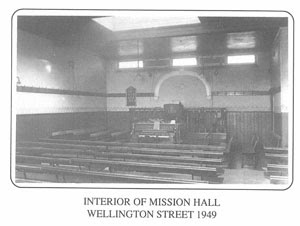
Two important innovations took place in November, 1904, firstly, extensive alterations were made to the Mission Hall to accommodate a growing congregation and the rapid increase of Sunday School scholars approaching four hundred. These renovations took several weeks, during which time the Hall could not be used, therefore, as a temporary measure the homes of Members were widely used. Secondly, the first Trust was dissolved and the number of Trustees increased to twenty-six.
The year 1912 marked a very special milestone when prolonged discussions took place regarding the possibility of building a brand new extension. This must have taken much heart searching having regard for the fact that after twenty years the Mission was still in it’s infancy and money was scarce.
Where was the finance coming from? The Trustees of the day as now, were not attracted to the idea of raising funds by Sales of Work, Christmas or Spring Fayre’s etc., but believed that if the project was in the will of God, the answer lay in sacrificial giving by the Members – and they were right. Older Members will remember that cardboard bricks were obtained and purchased by the congregation and Sunday School scholars. The building cost £300 of which £283. 1s. 1d. was donated, leaving a small deficit of only £16.18s.ld.
Apparently all the money needed was raised and, on the 9th October there was a Grand Opening Ceremony of the new building, known as the Lady’s Walk Infant School. The Silver Band headed a procession from Wellington Street into Mile End Road then to Lady’s Walk where the Opening was performed by Mrs. Grace Clark of Gosforth who was presented with a gold chased key. A large congregation then united in singing “All Hail the Power of Jesus’ Name” accompanied by the Band and following a short address by Mr. J. W. Payne and a solo from Miss Daisy Thompson, the Choir rendered the Cantata “Ruth”, after which everyone gathered in the Main Hall for tea.
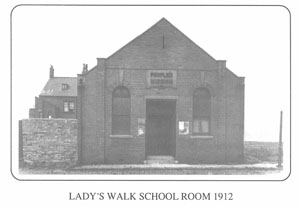
The l914-1918 Wars seemed in the early years to have had little affect on the life and work of the Mission to the extent that minor development continued. The Christian Endeavour Society expanded to accommodate children up to thirteen years old in a Junior Society and from thirteen years to eighteen years in an Intermediate Section and a Temperance Action Committee was also commenced. However, in 1915, due to the dark nights Children’s Services, Endeavour Meetings and Open-Air Meetings were all discontinued. For no apparent explanation all the above activities were re-commenced in February 1916 and in this respect there is a curious record regarding adequate lighting for the Band to play in the Open-Air during the winter when it was agreed to appoint Bros. Todd and Beck to be Lamp Carriers. Older folk will recall that these were lamps on a pole at each side of the rear of the Band, carried by two men. (Some years later Bandsmen used individual battery powered torches that clipped on the lapel or instrument).
There can be few people who have not heard of the Good Friday March to the Market Place, which in 1916 fell on 23rd April, but earlier in that year it was decided to obtain a new silk banner at a cost of £22.10s.0d. which was unfurled at a special gathering on 12th April, 1916. The ceremony was performed by a past Mayoress, Mrs. Usher, Alderman D. Richardson presided and Mr. T. Spencer President of the Sunday School Union was present. Solos were sung by Miss Adcock and Mr. Cook with cornet duets and solos by Bertie Peel and Fred Urwin.
However disaster struck, but let the Minutes of a later Meeting tell it’s own story, exactly as they were written :
“There was no Gathering in the Market on Good Friday owing to it being wet -therefore the School with Banner and Band missioned the Streets on Easter Sunday”.
To complete the events of 1916 there are two reports in the Minutes some readers may find quite moving and again here they are as they were written. “The Christian Endeavour reported an average attendance of 50 and 7 of our Young People professed conversion and attendances at the Sunday Evening Children’s Service now average 397”.
Despite the continuance of the Great War in 1917 there was cause for joy amongst the Members on 23rd May, when the Secretary, Mr. Bowman, produced the title deeds of the Mission. The record reads, “all present returned thanks to God that in His loving kindness we were able to say the Building was free of debt”. When examining the records one cannot fail to be impressed by the forward looking vision of the officials of that time for, now that the building was paid for, which for twenty-five years had been lit by gas mantles, they turned their minds to electric lighting.
A letter was then sent to the County Borough of South Shields Electric Supply Department, requesting a supply of electric energy, but on 3rd January, 1918, the Borough Electrical Engineer, H. S. Ellis, replied to the effect that the Mission would have to apply for a permit from the Ministry of Munitions authorising the work to be done and the necessary material supplied. Although the application was dutifully made, it appears that no acknowledgement was ever received and the Mission Hall in Wellington Street never did have the benefit of a supply of electricity.
The danger of highlighting the inestimable service given by what has become known as “stalwarts” of the Mission is, that no matter how much care is taken, inevitably someone will be missed out, to the disappointment of surviving relatives. An apology for such omissions is therefore offered in advance.
Notwithstanding this, there are revered brothers and sisters who must be mentioned. Typical examples are James Wilson Brimer and Cuthbert Peel, who seemed always to be linked one with the other. Mr. Brimer, as did Mr. Peel, came into the work of the Mission in the very early days and both held office for most of their lifetime. Mr. Brimer, the Assistant Treasurer was elected as Treasurer in May, 1920, a post he held until his death at well over ninety years of age.
Similarly Cuthbert (Cud) Peel was a tireless worker and Assistant Secretary for many years and despite the fact that when deafness overtook him at an advanced age.
” a group of Christians working together in a particular district or area, whose Mission is the conversion of the people”.
We will do as we have always done – rely upon God our Father who in His wisdom and graciousness has brought us thus far. The future is in His hands and as we endeavour to honour Him, so will the fellowship receive blessing upon blessing.
Turning back the clock to that October Saturday in 1949, one of the hymns sung in the Wellington Street Mission Hall was, “Guide Me O Thou Great Jehovah”, and truly, as we have been guided by Him in all things, we see no reason after one hundred years to change our direction.
Finally, readers will agree that we are living in an age of decadence when people have moved away from God and more churches are being closed than are being built. Even the People’s Mission is not immune from disaster, but there is a determination to continue to preach the pure Gospel in a way that will persuade those who hear it to repent of their sin and to know Christ *’ whom to know is life eternal”.
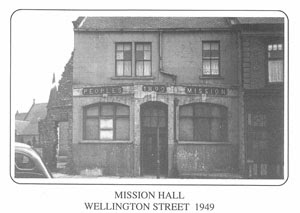
As you read this brief history of the Mission you once loved, we hope that your memories and hearts may be so stirred that you will want to “come back home”.
Sam Palmer,
Chairman of the Centenary Committee
March 1992.
